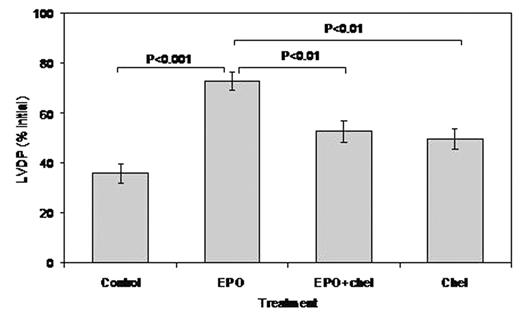Abstract
The biologic effects of erythropoietin (EPO) are mediated by its cellular receptor EPOR, a member of the cytokine receptor superfamily. EPOR expression in non-hematopoietic cells is associated with novel biologic effects for EPO in diverse organ systems. We recently demonstrated functional EPOR expression in adult rat cardiac myocytes and found that recombinant EPO exerts a rapid cardioprotective effect during ischemia-reperfusion injury of the isolated, perfused heart. Here we investigated the mechanisms of the cardioprotective effect of EPO using Langendorff-perfused rat hearts while left-ventricular-developed pressure (LVDP) was measured continuously to assess contractile function. Hearts were treated directly with EPO in the presence or absence of inhibitors of specific signal transduction pathways prior to normothermic global ischemia followed by reperfusion. Post-ischemic recovery of contractile function was determined by measuring LVDP at the end of reperfusion and expressed as a percentage of the baseline pre-treatment measurement. We investigated EPO-mediated activation of signal transduction pathways in the isolated, perfused heart and observed phosphorylation of p44/p42 MAP kinases ERK 1/2 (Thr202/Tyr204) and protein kinase B/Akt (Ser473), a downstream target of the phosphatidylinositol 3-kinase (PI3K) signaling pathway. Furthermore, EPO treatment of the isolated, perfused heart was associated with translocation of protein kinase C (PKC) ε and δ isoforms to the membrane fraction. We investigated the role of specific signaling pathways in EPO-mediated cardioprotection by employing inhibitors targeting PI3K, PKC and MAP kinase kinase (MEK1). PI3K inhibitors LY294002 and wortmannin attenuated EPO-induced phosphorylation of Akt but had no effect on EPO-mediated cardioprotection. MEK1 inhibitor U0126 had no effect on EPO-mediated cardioprotection. The PKC catalytic inhibitor chelerythrine (chel) significantly inhibited EPO-mediated improvement in post-ischemic recovery of LVDP (figure 1). Hearts pre-treated with EPO exhibited significantly improved post-ischemic recovery of LVDP compared to control hearts (mean±SE: 72±3 in EPO-treated versus 35±3% in control hearts, P<0.05 by ANOVA and Bonferroni post-hoc test, n=10 experiments each group) and the protective effect of EPO was significantly inhibited in chel-treated hearts (52±4% in EPO+chel versus 72±3% in EPO-treated hearts, P<0.05, n=10). As a control, treatment of the hearts with chelerythrine alone had no significant effect on LVDP (49±4%) compared to control hearts. These data demonstrate that EPO-mediated activation of the PKC signaling pathway is required for the cardioprotective effect of EPO during ischemia-reperfusion injury.
Author notes
Corresponding author


This feature is available to Subscribers Only
Sign In or Create an Account Close Modal